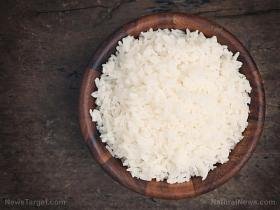Food safety tips: How to reduce the arsenic in your rice by 80 percent
Arsenic is a very toxic trace element. Throughout history, people have been ingesting it, either knowingly or unknowingly. This problem seems to be getting even worse, as more and more arsenic is making its way into people’s food, particularly rice.
Rice is a staple food for a huge percentage of the world’s population, which opens up the possibility that billions of people are unwittingly poisoning themselves.
Arsenic seeps into rice through use of pesticides, herbicides
Arsenic is making its way into rice because it is a naturally occurring substance. It can pop up in water, soil and rocks. The main sources of arsenic pollution come from the use of certain pesticides and herbicides, phosphate fertilizers, wood preservatives, industrial waste and mining activities, among other polluting industrial activity.
Arsenic often drains into groundwater. From groundwater, the toxic substance can find its way into water supplies that may be used by people for crop irrigation – such as with paddy rice.
Paddy rice is grown in flooded “paddy fields†that require a lot of irrigation water. In many parts of the world, this water is heavily contaminated with arsenic. To make matters worse, arsenic can also accumulate in the soil of paddy fields, and rice tends to absorb more arsenic than most food crops. (Related: Rice eaters beware: Study reveals fungicide and insecticide residues on rice hulls across a majority of samples.)
If you’re consuming rice more than two times a week, then you should also be concerned about arsenic in your system. One study, published in the International Journal of Environmental Health Research, found that American adults who consumed rice more than twice per week had significantly higher levels of arsenic in their urine.
Fortunately, there are ways for you to prepare rice that can remove most of the arsenic it may contain. This method was developed by Andrew Meharg, a fellow of the Royal Society of Edinburgh and a member of the Royal Irish Academy. (h/t to ModernSurvivalBlog.com)
- Soak your rice in water overnight. This opens up the rice grains, allowing any arsenic within it to escape.
- Drain the rice in the morning and rinse it thoroughly with clean water.
- For every one part of rice, add five parts of water.
- Arsenic usually leaves the rice during the cooking process. However, if you cook your rice until dry or if you use a rice cooker, the arsenic gets reabsorbed. Do not boil the rice dry. Cook the rice only until it’s tender.
- Drain any excess water from the rice and rinse it again with hot water.
If you want to further decrease your chances of getting poisoned, Meharg and fellow rice expert John Duxbury, a soil chemist from Cornell University, suggest buying basmati rice imported from India and Pakistan or jasmine rice imported from Thailand. According to their studies, these kinds of rice coming from these parts of the world contain the least amount of arsenic.
Comments
There are 0 comments on this post








